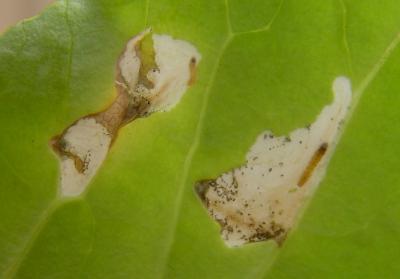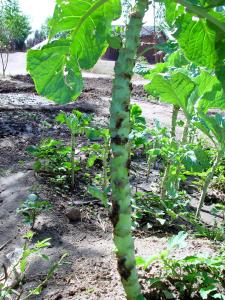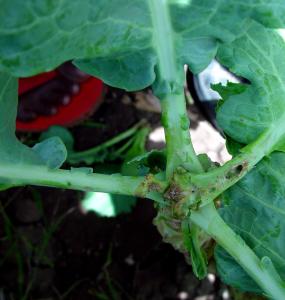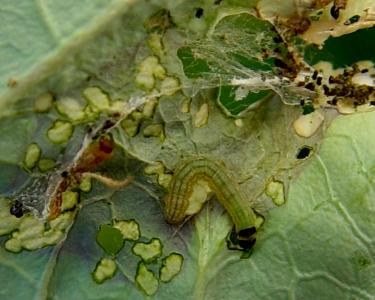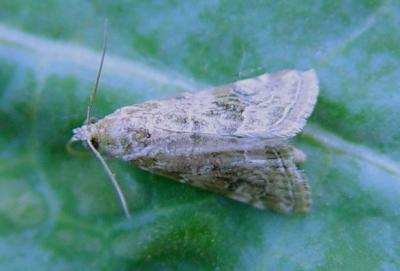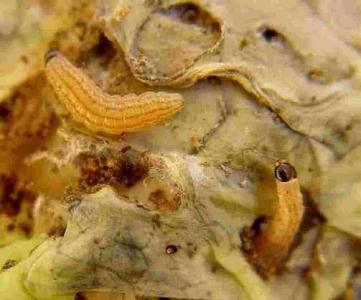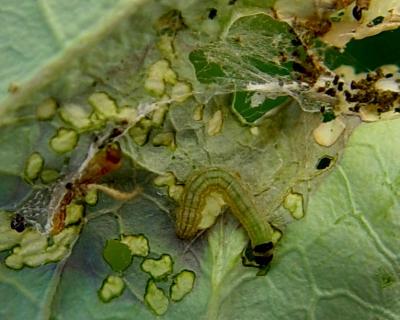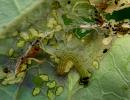
|
Cabbage webworm
Scientific name:
Hellula undalis
Order/Family:
Lepidoptera: Pyralida
Type:
pest (insect/mite)
Common names:
cabbage centre worm, cabbage borer
Host plants: Cabbage/Kale, Brassicas
|
General Information on Pest and Damage
Geographical distribution
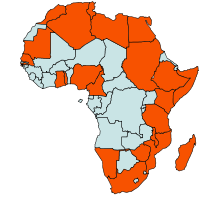 |
| Geographical Distribution of the Cabbage webworm in Africa (red marked) |
Damage
Young caterpillars mine the leaves while older caterpillars feed on the underside of rolled leaves within spun webs. Mature caterpillars (last instars) feed on leaves as well as stems and growing points. They are often hidden behind a web of silk and masses of frass (insect faeces). These are usually the first signs noticed.
Caterpillars feeding on young plants frequently causes death of the plants, especially when the larvae feed on the growing point. In older cabbage plants, new shoots are produced and the attacked plants produce several small heads of little commercial value. Caterpillar feeding after heading may cause head stunting. In addition, insect feeding and the presence of caterpillars and/or their excrement reduce the market value of the produce. On kale, young caterpillars mine in the leaves and older caterpillars bore into the stem of the plants. Frass accumulated at the entrance of the tunnel along the stems is an indication of damage.
|
|
|
Host range
Principal host plants are cabbage, Kale and all other brassica crops (cauliflower, kohlrabi, broccoli etc). Cauliflowers appear to be the preferred food plant of the cabbage webworm. It is also found feeding on radish. Symptoms
Young caterpillars mine leaves, bore stems and feed externally on the leaves. They then often penetrate the heart of the plant destroying the terminal bud, and prevent heading. While feeding they spin a silken tube. Plants wilt, and frass is exuded from the affected plant parts.Affected plant stages
Flowering stage and vegetative growing stage. Affected plant parts
Growing points, inflorescence, leaves, stems and whole plant. Symptoms by affected plant part
Growing points: external feeding. Inflorescence: wilt.
Leaves: external feeding; internal feeding; webbing.
Stems: internal feeding.
Whole plant: dead heart; wilt.
Biology and Ecology of the Cabbage Webworm
Caterpillars are creamy white with light pinkish brown stripes along the body and have a black head. Mature caterpillars have faint stripes. They measure 15 mm when fully grown. Duration of larval development varies between 6 to 18 days, depending on temperature and on the host crops. Thus, on cabbage larval development is completed in 16 to 19 days, but on cauliflower it may require only 11 to 13 days.
|
|
The pupae are shining pale brown with a dark dorsal stripe. Pupation occurs in leaf tissue, in tunnels made by the feeding larvae inside the stem. Adults emerge in 7 to 8 days
Adult moths are greyish-brown in colour, small and rather delicate with a wingspan of approximately 1 cm. Each front wing has a black spot and zigzagging pale brown lines.
The adult moth is capable of flying long distances and occasionally migrates to areas well outside its normal breeding range. Adult lifespan is about 4 to 8 days.
|
|
Pest and Disease Management
Pest and disease Management: General illustration of the concept of infonet-biovision
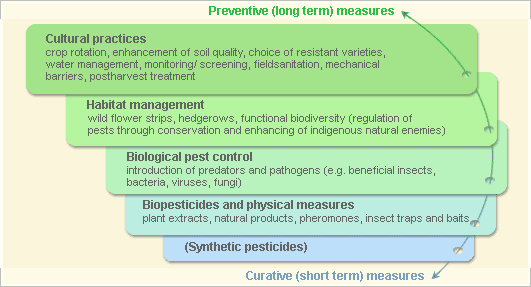
Further below you find concrete preventive and curative methods against Cabbage webworm.
Cultural practices
Monitoring
Regular monitoring of young plants in the nursery and after transplant is important. Inspect crops for the presence of caterpillars and damage symptoms. Use clean planting materials: transplant only healthy, vigorous insect-free seedlings.
Field sanitation
Uprooting and burning of cabbage and kale stalks and crop rotation are important to reduce field populations.
Biological pest control
Natural enemies
Natural enemies of the cabbage webworm include parasitic wasps (such as braconid, ichneumonid and chalcidoid wasps). Conservation of these natural enemies is important. Care should be taken when deciding on options to manage this or other cabbage pests. The cabbage webworm frequently occurs in the same areas where aphids and diamondback moths are major pests. This may complicate the control of cabbage webworm, since pesticides used to control aphids, and other pests, may kill natural enemies of the cabbage webworm resulting in outbreaks of this pest.
For more information on natural enemies click here.
Biopesticides and physical methods
Bt (Bacillus thuringiensis)
Bacillus thuringiensis var. aizawai and Bt var. kurstakiare very effective in controlling infestations of the cabbage webworm. Bt var. kurstakiis is used at a weekly interval and a rate of 0.5/ha. This type of strategy provides effective control of the cabbage webworm. However, continuous use of Bt can induce development of resistance.It is important to start control measures early when caterpillars are still young and have not yet penetrated plant tissue.
Bt is a naturally occurring soil bacterium that causes disease on insect pests. It is accepted as an alternative in organic farming and is considered ideal for pest management because it is host specific and is non-toxic on natural enemies and on humans.
Bt is commercially available in most agricultural suppliers. It is sold in various formulations (spray, dust, and granule) and strains (Bt tenebrionis, Bt kurstaki, Bt israelensis, Bt aizawai, Bt san diego).
Products: Bt products in Kenya are sold under the following commercial names: Dipel®, Javelin®, Thuricide® and Xentari®. They kill the cabbage webworm and do not harm beneficial insects.
Application: Bt insecticides should be applied when the first L1-larvae are appearing. Sprays may need to be applied at intervals of 5 to 7 days when populations are high. Because Bt insecticides are UV-degraded treat crops in the late afternoon.
For more information on Bt click here.
Spinosad
Spinosad®, a broad-spectrum insecticide derived from fermentation of the naturally occurring soil bacterium Saccharpolyspora spinosa, controls many caterpillars, leafmining flies, and thrips. It is useful for the management of caterpillar pests in brassicas, including the diamondback moth, the cabbage looper and the cabbage webworm. Spinosad® has low activity against most beneficial insects. Farmer experiences - homemade biopesticides
Farmers in some countries produce their own homemade biopesticides by collecting diseased diamondback moth larvae (fat and white or yellowish or with fluffy mould on them), crushing them and mixing them with water in a blender. Large tissue clumps are filtered out and the liquid is sprayed onto the crop (Dobson et al, 2002).This preparation is equally against the webworm.
Neem
Botanicals, especially neem-based insecticides give good control of the cabbage webworm. Weekly applications of neem products afforded good control in Togo (Ostermann and Dreyer, 1995).
It is important to start control measures early when caterpillars are still young and before they have penetrated plant tissue.
For more information on Neem click here.
Information Source Links
- Kessing, J. L. M. and Mau, R. F. L. (1992). Imported cabbage web worm. Hellula undalis (Fabricius). Crop Knowledge Master. Updated by: J.M. Diez April 2007.
- CABI (2005). Crop Protection Compendium, 2005 Edition. © CAB International Publishing. Wallingford, UK. www.cabi.org
- Ostermann, H. and Dreyer, M. (1995). Vegetables and grain legumes. In 'The Neem tree Azadirachta indica A. Juss. and other meliaceous plants sources of unique natural products for integrated pest management, industry and other purposes'. (1995). Edited by H. Schmutterer in collaboration with K. R. S. Ascher, M. B. Isman, M. Jacobson, C. M. Ketkar, W. Kraus, H. Rembolt, and R.C. Saxena. VCH. pp. 392-403. ISBN: 3-527-30054-6
- Varela, A. M., Seif, A., Löhr, B. (2003). A Guide to IPM in Brassicas Production in Eastern and Southern Africa. ICIPE www.icipe.org
- www.extento.hawaii.edu

 Back
Back
